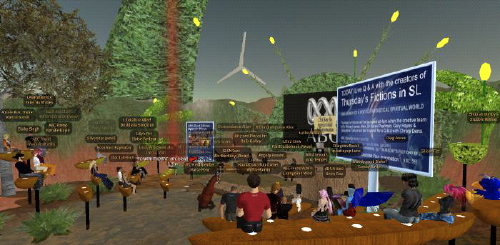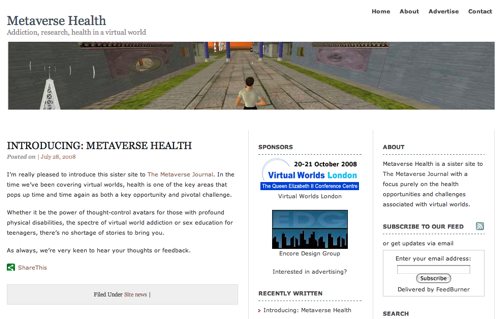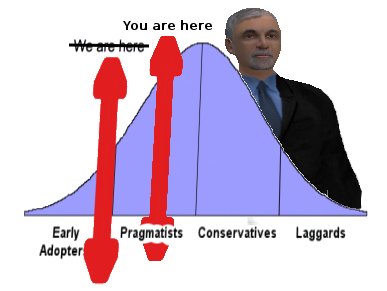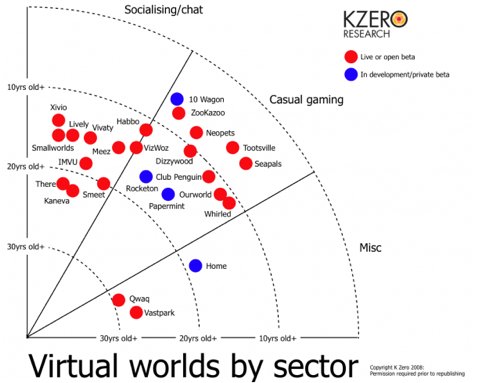We highlighted some poor mainstream reporting on Second Life and covered a successful event on ABC Island.

Tech -- Culture -- Humour
We highlighted some poor mainstream reporting on Second Life and covered a successful event on ABC Island.

To coincide with their latest vBusiness Expo, Clever Zebra have released two white papers – available at no cost.

The first is The Essential 7 Point Quick Start for Meetings Professionals, the other is Going Virtual: A Three Point Success Plan for Business.
To get copies, click on the incorrectly titled ‘Download your copy now’ links at this page – you’ll then need to enter your name and email address and then wait a day or so to be emailed the documents. That said, I did get my copies within an hour or so.
The documents themselves are aimed squarely at businesses not yet fully engaged with virtual worlds, and in that context these are quite useful and simple to read. For the more informed there are some contentious statements made. An example:
A Virtual World does not have rules, quests, or any kind of narrative associated with it.
World of Warcraft is not a Virtual World.
That’s one narrow view of virtual worlds – albeit one that will appeal to larger businesses who will have a natural aversion to gaming-based scenarios. Credit where credit’s due though, Clever Zebra don’t beat about the bush about Second Life’s stability issues:
Second Life is notoriously unstable, and regularly crashes, or limps along with limited
inworld services as the system experiences peak loads.
Overall, these two documents are worthy additions to the growing free body of knowledge for business in virtual worlds.
I’m really pleased to introduce a new sister site to The Metaverse Journal: Metaverse Health. It’s a completed site now but expect further enhancements in coming weeks.

In the time we’ve been covering virtual worlds, health is one of the key areas that pops up time and time again as both a key opportunity and pivotal challenge. Whether it be the power of thought-controlled avatars for those with profound physical disabilities, the spectre of virtual world addiction or sex education for teenagers, there’s no shortage of stories to bring you.
As always, comments and feedback welcome. Also, if health and virtual worlds is a passion and you’d like to write about it, contact us to discuss your ideas further.

Second Life is going through a troubling phase. It has entered young adulthood, but is still acting like a teenager – occasionally like a teething two-year-old in a tantrum. Unfortunately, Linden Lab has a very different view about where the Second Life product stands with regards to its consumers: they believe that they are providing a frontier product to the disorganized nomads of the virtual worlds. I believe this is far from the case, and that in fact the frontiersfolk have long since passed into obscurity and myth, and that this rustic product is now being peddled to a bunch of sophisticated townsfolk.
Second Life‘s frontiersfolk, the early adopters of the adoption bell curve of Kapor’s speech, have been leaving Second Life to become the early adopters of other technologies since mid-2005. The townsfolk or pragmatists have long since taken over; and though there are still hopefully many more of them to come, the townsfolk now represent a majority. It’s possible that Kapor managed to alienate both the frontiersfolk and the townfolk when he said, in essence, from the town square, “See here, all you woodsy hicks, y’all have to move over and make way for the townsfolk who’ll be moving in.”
So here we all are, a bunch of townies, doing our best with hides and stone knives to build a comfortable living for ourselves. It’s not easy, but despite the tools we’ve been given, we’re making our way nicely, thank you. We’ve workarounds galore to overcome limitations in the product (insufficient personal profile and group tools, etc), although there are still many problems that we must simply endure – an ongoing lack of stability, a poor permissions system for functional collaboration, a set of tools that are feature-rich for individuals and feature-poor for groups, and many, many others that simply make life less easy (feet sinking through terrain, poor Search functionality, the list goes on).
Microsoft, for all their other failings, did a good job of matching their product maturity to the adoption curve. Linden Lab is failing to do this. Windows versions up to 3.0 were for the innovators and early adopters. Increased stability and an increased feature-set were designed to encourage the pragmatists to buy and use their 3.1 version, and so on down the line. Linden Lab is still throwing version 1.0 grade features at customers who are expecting 3.1 quality. They are ramping up to pave the way for their 3.1-quality product targeted to attract new customers, however many of these people are already using it or have already tried and failed.
The townies are crying out for quality and beauty in their town. We like our solid buildings and manicured gardens, and a sign saying “Welcome To Our Town”. How does this translate? Aside from addressing the problems from above, two things come to mind: more social networking tools and superior orientation. If Second Life is to be truly hailed as a social networking haven, it needs the tools to support that boast, instead of people finding that they can work around the restrictions of the system. For Second Life to be welcoming, the whole orientation system needs to be addressed. Right now, no orientation at all would be better than what is currently available.
If Kapor, Kingdon and the rest of the team up at Linden Lab still think that we’re just passing out of the early adoption phase, we need to be prepared for a continuing disconnect between the Linden Lab view of the product and the consumer’s view – that is, how the product is actually being used.
1. Kotaku (USA) – Virtual Worlds for Fun and Research. “We mentioned Arden, the university-design MMO, a few times; a working paper has just been released that looks at economic behavior in MMOs using the game. The interesting thing here isn’t so much the fact that people replicate real-world behaviors online (in this case, they purchased less of an item when it was more expensive), but that it’s yet another piece of a growing literature explaining the utility of virtual worlds in actual research”.
2. Wired (USA) – Gaia Online Launches zOMG Beta. “The vast virtual world of Gaia Online is expanding yet again, with the just-launched closed beta of — I’m not making this up — zOMG. This latest, free addition brings Gaia into line with more traditional MMO titles. While it has earned nearly 6 million users with a clever, teen-centric blend of social networking and casual gaming in the past, zOMG adds a world to explore, roleplaying elements and semi-real time combat.”
3. The Province (Canada) – Professor who gave acclaimed ‘last lecture’ dies. “The American university professor whose “last lecture” made him an Internet sensation has died at age 47 of complications from pancreatic cancer. In August 2007 Randy Pausch, who taught at Carnegie Mellon University in Pittsburgh, Pa, was told by doctors he had three to six months .”
4. Gwinnett Herald (USA) – Tradition married to technology in toys. “Kiz Toys is about three things, Moreau said: safety, innovation and education. “What we’ve done is taken traditional toys that parents are comfortable and familiar with, whether cars, action figures, whatever they would be, and introduced… technology. We’ve kind of blended the best of both worlds,” he said. Everything in the Kiz Toys product line focuses on having an educational value. Technology comes in with the online interactive nature of the toys. Children can interact anonymously in secure settings online.”
5. Computerworld (USA) – Intel: Human and computer intelligence will merge in 40 years. “At Intel Corp., just passing its 40th anniversary and with myriad chips in its historical roster, a top company exec looks 40 years into the future to a time when human intelligence and machine intelligence have begun to merge. Justin Rattner, CTO and a senior fellow at Intel, told Computerworld that perhaps as early as 2012 we’ll see the lines between human and machine intelligence begin to blur. Nanoscale chips or machines will move through our bodies, fixing deteriorating organs or unclogging arteries. Sensors will float around our internal systems monitoring our blood sugar levels and heart rates, and alerting doctors to potential health problems.”
6. San Diego Union-Tribune (USA) – At the top of their game . “There’s no mortgage meltdown in Metropolis. Building is booming in Gotham. Everywhere you look, development is proceeding at flat-out Batmobile speeds. It’s true that all this construction is happening in the fantasy world of DC Comics’ new, massive-multiplayer online (MMO) game. It’s also true that to those who immerse themselves in these hugely popular, role-playing adventures, the characters and settings can seem more real than this planet we call Earth.”
7. The Guardian (UK) – Economic petri dishes: there’s social science in them thar virtual worlds. “In Thursday’s gamesblog column, I wrote about the data that companies and academics are collecting on us as we frag, chat and slay. The extent to the collection is pretty awesome, and believe me, so is the analysis; I’ve spent the better part of the last two years trying to make sense of an immense Second Life dataset. But enough about my PhD, here’s someone who’s actually got some results. Economist Edward Castronova, he who famously calculated the GDP of EverQuest back in 2002, and his team of merry men and women have completed their MacArthur Foundation-funded Arden Project in which they built a virtual world, split it into two and played around with the economic principles in each to assess the economic validity of virtual environments.”
8. Gameplanet (New Zealand) – World of Warcraft achievements detailed. “It was confirmed last week that one of features of the upcoming World of Warcraft expansion pack, Wrath of the Lich King would be the addition of an achievements system.”
9. Christianity Today (USA) – The First Church of Second Life. “There is another life beyond this one: a realm where one’s role on earth is a distant memory, where inhabitants have new bodies and can fly anywhere they like. It sounds a bit like heaven. But it’s not. It’s cyberspace.”
Oscar Niemeyer’s work has gained many plaudits over the years and his architecture is now gaining some attention in Second Life, thanks to Hidenori Watanave and a student team from Tokyo Metropolitan University (Kanako Hayashi, Kaname Shimizu, Makiko Suzuki, Ryuta Kawahara and Yohei Nakano).

A 3D image database of Brazilian Niemeyer’s work is being developed and the team will spend a week in Brazil in early August. It’s all part of the 100th anniversary of the exchange relationship between Japan and Brazil. The current build is quite striking so I’m looking forward to seeing the final product.
Second Life blogger Dusan Writer has written a detailed article on the impact he believes brands have had on virtual worlds and the trend toward smaller virtual worlds.
His tone is best summed up by this paragraph:
And this social media stuff has been a drag too. Best we could do for the poor suffering brands was to come up with the idea of “viral” – which really means “something short, like a commercial, only we’ll get consumers to pass it around rather than pay for media placement”. Because look, everyone’s ignoring your banner ads on youTube, and if you get involved with Facebook widgets you might end up next door to some rocker chick posting half-naked pictures of herself and joining the “I Slept with Someone On Facebook” group, and that’s can’t be so hot for brand equity right?
The section showing different worlds and their alleged immersive elements is worth a look alone.
What say you?
Linden Lab’s CEO, Mark Kingdon , has detailed his perceptions of his first two months at the helm on the official Linden Lab blog.
He makes five key points:
1. Second Life users are more mainstream than many assume.
2. The diversity of use cases in Second Life is mind-boggling.
3. Second Life has an enviable business model.
4. Second Life’s killer apps are just beginning to evolve.
5. Second Life is leading the industry toward interoperability.
It’s an lengthy read but my overall impression is it was similar to a pitch a CEO might make for a second or third round of venture capital funding.
What do you think? Do you see a new CEO with a vision for Second Life’s future or someone pitching for more time to pull things together?
“Hey. we’ve done some brilliant stuff here and the best is yet to come” is the overall message. The excitement shown toward Second Life as a meeting application is insular to say the least – some of the upcoming mirror worlds are likely to gain significant traction in this space as they demonstrate superior interfaces, easier setup and better performance.
A promise is made on a separate announcement on usability – to me this remains the number one challenge for a virtual world ground-breaker at risk of being run over by the convoy of tractors coming up behind with some tempting crops to plant.
1. Second Life Augmented Reality in Physical Space
Kathryn Greenhill films an installation at the John Curtin Art Gallery at Curting University in Western Australia: “The installation involves the user wearing a headset with a webcam, looking through goggles and using a paddle to “liberate” a 3D avatar from within Second Life.”
2. Just Dance – Second Life – Sine Wave Dance
3. Second Life — Relay for Life Sims Tour Part One
Metrics gurus Kzero have released a new breakdown of the age variances by type of virtual world frequented.

There’s no big surprises but the figures do further emphasise the power of the pre-teen and teen market for social virtual worlds.
Thanks to Pavig Lok for the heads-up.
Copyright © 2024 · Magazine Child Theme on Genesis Framework · WordPress · Log in
Recent Comments